 Image search results - "art" Image search results - "art" |

Omi Fair video taken on March 2, 2014 at Takashimaya Dept. Store in Nihonbashi, Tokyo. Funazushi, Omi beef, Biwa pearls, and more. We also saw Hiko-nyan.
|
|

About Genova ジェノバの紹介Genova (or Genoa) is a port city on the west coast of Italy. It is the birthplace of Christopher Columbus. For 2004, it was designated as the European City of Culture. From Milan, it takes about 90 min. to reach Genova.
ジェノバは、イタリアの北の西海岸にある港街です。コロンブスの出身地でもあります。ミラノから電車で約1.5時間かかります。
|
|

Tokyo Shiga Kenjinkai New Year's Party 2007 平成19年 東京滋賀県人会 新年賀詞交歓会Party fee was 7,000 yen.
|
|

Way to Takashimaya Dept. Store in Nihonbashi subway station.
|
|

National Diet members in Tokyo representing Shiga Prefecture. 滋賀の議員
|
|

Way to Takashimaya Dept. Store in Nihombashi subway station.
|
|

Each Diet member gave a short speech.
|
|
|
|
|

Takashimaya got its name from Takashima, Shiga Prefecture.
|
|

Buffet dinner in Providence Hall, Tokyo Prince Hotel
|
|

1st floor of Takashimaya Dept. Store.
|
|

Buffet
|
|

Exhibit of Nagahama bonsai plum trees and folding screen from Hikone, 1st floor of Takashimaya Dept. Store during the Grand Omi Fair.
|
|

Mochi-tsuki 餅つき大会
|
|
|

Mochi for all, dressing was grated daikon and dried bonito shavings.
|
|

Folding screen from Hikone (National Treasure).
|
|

Live orchestra playing swing jazz. 有川新二&ザ・グレイ・ラスカルズオーケストラ「なつかしのスウイングジャズ」
|
|

PR exhibit for the Grand Omi Fair on the 8th floor.
|
|

Drawing for prizes donated by Shiga businesses. 抽選会
|
|
|
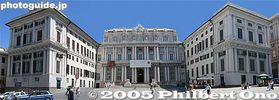
Palazzo Ducale, site of the Japan art exhibition in 2005 (Giappone - L'Arte del mutamento). (展覧会の会場)From April to Aug. 2005, a huge Japanese art exhibition was held at this former palace. It exhibited ukiyoe, posters, textiles, and photographs. The photo exhibition, curated by Rossella Menegazzo and myself (Philbert Ono), showed images of the Hiroshima and Nagasaki atomic bomb aftermath.
2005年4月〜8月にイタリアのジェノバ市で日本の美術展覧会が開催され、浮世絵、着物、アートポスターと写真が展示されました。 写真展は、60周年のため広島・長崎原爆関係の写真が紹介されました。会場は、立派なドゥカーレ宮殿でした。
|
|

Prizes. 抽選会の景品
|
|

1st floor of Takashimaya Dept. Store.
|
|

People come to claim their prizes. 景品を受ける
|
|

Grand Omi Fair on 8th floor
|
|

Consolation prize for people who didn't win anything. 当たらなかった人にも残り少々の景品
|
|

Tourist corner with samurai armor of Hikone's Ii Clan.
|
|
|

Singing "Biwako Shuko no Uta" 琵琶湖周航の歌
|
|
|

Singing "Biwako Shuko no Uta"
|
|

Funa-zushi 鮒寿し
|
|

Singing "Biwako Shuko no Uta" in a large circle.
|
|
|

Banzai
|
|

Fish and shellfish from Lake Biwa
|
|

Everyone got to take home a gift bag of negi green onions, mochi, and other goodies.
|
|

Ibuki Ham
|
|

Gift bags.
|
|

Ibuki Ham
|
|

Vegetable jam
|
|

Close-up of sign above the entrance to Palazzo Ducale
|
|

Omi beef, each pack here cost over 2,000 yen. 近江牛
|
|
|

Stamp of Approval from Shiga
|
|

Mochi making
|
|
|
|

Mochi
|
|

Adoberry sweets, from Adogawa, Takashima.
|
|

Adoberry sweets, from Adogawa, Takashima.
|
|
|
|

Entrance to crafts booths. 工芸展
|
|

Omi crafts booths
|
|
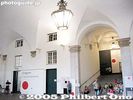
Inside the Palazzo DucaleAs soon as you enter, this is what you see. The lower left is the entrance to the bookstore, and the stairs go up to the textile and ukiyoe exhibition.
|
|

Kimono in the middle costs 1,995,000 yen. However the most expensive thing I saw was a Buddhist altar selling for 40 million yen (lots of gold leaf).
|
|

Making candles.
|
|

Kids enjoy riding around the park.
|
|

The man at the corner makes sure the kids obey the traffic rules.
|
|
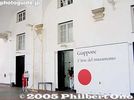
Museum shop entrance and tanabata display.This was taken on July 9, 2005 which is close to Tanabata.
|
|
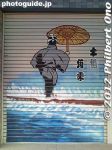
Store shutter art of Kiba kakunori in Koto, Tokyo.
|
|

Entrance to Hiroshima-Nagasaki photo exhibition 広島・長崎原爆写真展の入口
|
|
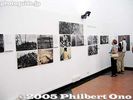
Hiroshima photos 広島原爆写真
|
|

Hiroshima panorama photos by Shigeo HayashiThe exhibition room was divided in half by this panel. The right side was for Hiroshima, and the left side for Nagasaki.
|
|
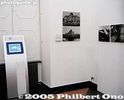
Video monitor showing Hiroshima
|
|
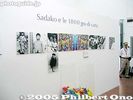
Sadako and her origami cranesBased on a story of a girl named Sadako who was exposed to the atomic bomb in Hiroshima. She was told that if she folded 1,000 paper origami cranes, she would be granted a wish. But she died at age 12 even after folding over 1,000 paper cranes.
|
|
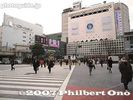
Shibuya Station
|
|
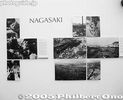
Nagasaki photos by Yosuke Yamahata 山端庸介が原爆投下翌日の写真を撮ったYosuke Yamahata was an Imperial Army photographer who was ordered to go to Nagasaki to photograph the after effects of the atomic bomb. He and two others, a writer and an artist, arrived in Nagasaki the morning after the bomb was dropped. Yamahata went on to capture over 100 extraordinary images of the devastation, people who survived, people helping the wounded, and the inevitable corpses.
山端庸介(1917−66)は陸軍報道カメラマンとして原爆投下翌日の長崎に入り,100枚以上の非常に貴重な歴史的の写真を撮った。長崎原爆資料館にも大きく展示されている。
|
|
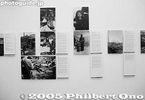
Nagasaki photos by Yosuke Yamahata. 写っている人物の当時の状況が詳しく語っています。In 1995, NHK, Japan's leadning TV station, successfully identified some of the survivors pictured in Yamahata's photographs. They even interviewed some of them who were still living. They aired a special TV program and published a book about the extraordinary stories of the survivors.
Those stories have been summarized into Italian for the photo captions in this exhibition.
写っている人物の当時の状況が詳しく語っています。10年前にNHKの取材班が山端庸介の原爆写真に写っている人物の名前とか所在を調べてまだ生きている何人かとインタービューが成功。それが、テレビ番組と本「NHKスペシャル 長崎 よみがえる原爆写真」になって大変感動しました。(テレビ番組も昨年8月に再放送された。)
そのNHK Special番組と本を参考してこの新しい写真集の写真説明文を書きました。イタリア語になっていますが、それぞれの写真を今まで外国語で詳しく説明されたことないのです。被爆者の感動的の話しをもっと海外にも伝いたいのです。
|
|

Nagasaki photos by Yosuke Yamahata
|
|
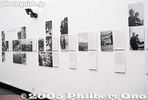
Nagasaki photos by Yosuke Yamahata
|
|

Nagasaki photos and origami corner 折り紙コーナーVisitors were encouraged to fold a paper crane.
|
|
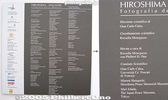
Panel for exhibition credits クレジットRossella Menegazzo and Philbert Ono were co-curators of the photo exhibition.
イタリア側でこの展覧会と図録のコーディネートをしているRossella Menegazzoさんは、ちょっと古い友人です。彼女は素晴らしい頑張りやさん。まだベネチア大学の学生のとき、夏休みに来日して僕と会いたいと言われて都内のピザ屋(彼女のバイト先)で初めて会ってあげた。
「卒業論文のため、日本人の写真家を研究したい!」と言い出してびっくりしたよ。「木村伊兵衛か土門拳、どっちがいいと思う?」と聞かれても答えないよ。(結局、土門拳になった。)しかし、参考書はほとんど日本語で英語の参考書も(僕のHP以外)非常に少ないと指摘した。でも3年後、なんとイタリア語で土門拳の論文が完成された。これは、イタリア国内で史上初の日本人写真家の論文である。ということは、彼女が日本語も勉強して読めるようになったの。凄いでしょう。
で、話しがまだ続く。彼女の草分けの論文のおかげで大学の後輩も二人、三人が日本の写真家の論文を書いたりしているの。その後輩たちにも僕ができる限り参考書など送っています。(向こうは喜ぶね。)でも、その学生さんが日本人の写真家を論文のためにインタービューしようとすると拒否されることがある(例えば奈良原 一高)。それを聞くと僕はとても恥ずかしい気持した。一方、森山大道の論文を書いた学生が本人とのインタービューが成功した。彼女がとても喜んでいたそうです。(大道さん、ありがとう。)
|
|

Nagasaki exhibition catalog: Yosuke Yamahata-Nagasaki 山端庸介の新しい写真集兼図録This book shows all of Yosuke Yamahata's photos of Nagasaki, including the the 100+ photos of Nagasaki taken on the day after the bomb was dropped. The book includes a photo which has never been published in a book. Many detailed captions about the people identified in the photos are also included. Language is Italian. Order from PhotoGuide Japan's iStore.
山端庸介(1917−66)は陸軍報道カメラマンとして原爆投下翌日の長崎に入り,100枚以上の非常に貴重な歴史的の写真を撮った。長崎原爆資料館にも大きく展示されている。
過去に山端庸介の写真集が国内外に出版されたことあるけど、撮った写真の一部しか紹介されていませんでした。今回の新しい写真集は、山端庸介の長崎関係の全集の写真集とも言えます。本に出版されたことない写真もあります。1946年に撮った写真もあります。
そしてもう一つの大きな特徴は、説明文。写っている人物の当時の状況が結構詳しく語っています。10年前にNHKの取材班が山端庸介の原爆写真に写っている人物の名前とか所在を調べてまだ生きている何人かとインタービューが成功。それが、テレビ番組と本「NHKスペシャル 長崎 よみがえる原爆写真」になって大変感動しました。(テレビ番組も昨年8月に再放送された。)
そのNHK Special番組と本を参考してこの新しい写真集の写真説明文を書きました。イタリア語になっていますが、それぞれの写真を今まで外国語で詳しく説明されたことないのです。被爆者の感動的の話しをもっと海外にも伝いたいのです。
|
|
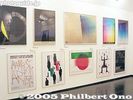
Poster exhibition 日本のポスター展In the huge, cavernous basement of the Palazzo Ducale, over 600 artistic Japanese posters were on display.
地下の凄い大きいホールになんと600枚のポスターが展示。
|
|

Poster exhibition
|
|
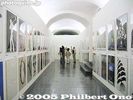
Poster exhibition
|
|

Poster exhibitionA few expo posters. Even those poster designs which were not selected to be the official poster design were included in this exhibition.
|
|
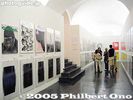
Poster exhibition
|
|

Poster exhibition
|
|

Poster exhibition catalog: Manifesti D'Artista 1955-2005 ポスター展の図録All 600 posters featured in the exhibition is reprinted in this thick catalog called "Manifesti D'Artista 1955-2005," published by Ideart. Language is Italian. Order from PhotoGuide Japan's iStore.
|
|
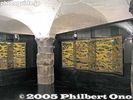
Folding screen 屏風も
|
|
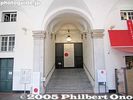
Upstairs to the textile and ukiyoe exhibitions 二階へ二階に織物展と浮世絵展が開催。
|
|
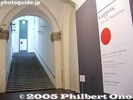
Upstairs to the textile and ukiyoe exhibitions 二階へ
|
|

Textile exhibition 織物展The textiles were exhibited in the best rooms of the Palazzo Ducale, including the chapel shown here. Beautiful frescoes decorated the walls and ceilings. What a contrast it was between the Japanese kimono and religious motif.
織物は宮殿の一番豪華な多数の部屋に展示された。
|
|

Textile exhibition 織物展The textiles included kimono, noren curtains, and stenciled works.
着物、のれんなど展示された。
|
|

Textile exhibition catalog: Avvolti Nel Mito 織物展図録The textiles exhibited are shown in this catalog called "Avvolti Nel Mito" (Wrapped in the Myth) published by Ideart. Language is Italian. Order from PhotoGuide Japan's iStore.
|
|
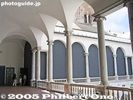
Entrance to ukiyoe exhibitionThis is the second floor (in Italy, it's called the first floor). And what we in Japan and the US call the 1st floor is the zero floor in Italy.
|
|

Entrance to ukiyoe exhibition 浮世絵展の入口
|
|

Entrance to ukiyoe exhibition 浮世絵展の入口
|
|
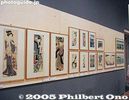
Ukiyoe exhibition 浮世絵展The ukiyoe collection came from the Chiossone Museum in Genova. The collection was amassed by Genova native and printing expert Edoardo Chiossone (1833-98 who was dispatched to Japan in 1875 to help Japan modernize its printing technologies (for printing money, etc.). During his 23 years in Japan, he acquired thousands of Japanese art works, especially ukiyoe which numbers 4,000 works. He never returned to Italy and died in Japan.
ジェノバ出身の彫刻師エドアルド・キヨッソーネ(1833-98)は、1875年大蔵省紙幣寮(のちの内閣印刷局)の求めに応じて来日。当時、日本の近代化を推進していた明治政府は外国から優れた技術者を「お雇い外国人」として招いており、キヨッソーネもその一人でした。日本近代印刷技術の礎を築きます。
キヨッソーネの日本滞在は24年にわたり、ついに祖国イタリアへ戻ることなく日本で生涯を終えますが、その間に日本美術に触発され約15,000点余りの美術品を収集するに至ります。なかでも浮世絵のコレクションは4,000点におよび、コレクションのなかでも最も充実したジャンルを形成し世界有数の浮世絵コレクションとして知られています。現在はジェノバ市立キヨッソーネ東洋美術館が所蔵されています。
|
|
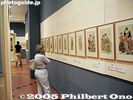
Ukiyoe exhibition
|
|
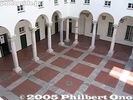
Palazzo Ducale courtyard
|
|
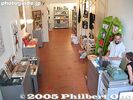
Ideart bookstore 図録の出版社であるIdeartの会場内売店(展示期間のみ)At the end of the poster exhibition hall, you enter this bookstore where you can buy all the exhibition catalogs, Japanese books (in Italian), and other neat things. This Ideart (publisher of the exhibition catalogs) bookstore operated only during this exhbition.
|
|
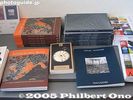
Exhibition catalogs 図録Order from PhotoGuide Japan's iStore.
|
|
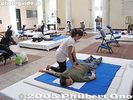
Shiatsu demonstrationThe other courtyard of the Palazzo Ducale had shiatsu demonstrations when we were there in July. During the exhibition, various Japan-related events and demonstrations were held such as taiko drumming and martial arts.
|
|
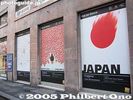
Posters at Genova Fnac Bookstore 市内のFnac本屋でPRThe Fnac Bookstore was generous enough to provide space on their outdoor walls to publicize the exhibition with replicas of the posters and photos.
フランスに本社がある大手本屋さんのFnacのジェノバ店で今回の展覧会をPRするために展覧会関係の巨大ポスターを店の壁に張ってくれました。
|
|

Posters at Genova Fnac Bookstore
|
|

Posters at Genova Fnac BookstoreShot of bombed Nagasaki above one entrance.
山端庸介の長崎原爆写真も入口の上に。
|
|
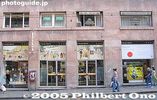
Ukiyoe at Genova Fnac BookstoreUkiyoe decorates the bookstore facing the main street.
|
|
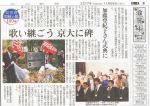
Chunichi Shimbun article (Nov. 26, 2017) about Kyoto University's celebration of the 100th anniversary of Biwako Shuko no Uta including the unveiling of the new song monument on campus.
|
|
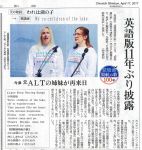
Chunichi Shimbun article (April 17, 2017) about our Lake Biwa Rowing Song mini concert held in Imazu on April 16, 2017. See videos of this event here: https://youtu.be/9G94IppUiiE
https://youtu.be/PjnY67sIcqE
|
|
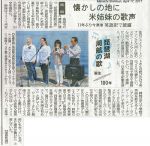
Mainichi Shimbun article (April 17, 2017) about our Lake Biwa Rowing Song mini concert held in Imazu on April 16, 2017.
|
|
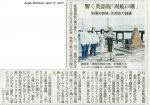
Asahi Shimbun article (April 17, 2017) about our Lake Biwa Rowing Song mini concert held in Imazu on April 16, 2017.
|
|

Sankei Shimbun article (April 17, 2017) about our Lake Biwa Rowing Song mini concert held in Imazu on April 16, 2017.
|
|

Yomiuri Shimbun article (April 17, 2017) about our Lake Biwa Rowing Song mini concert held in Imazu on April 16, 2017.
|
|
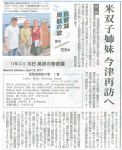
Mainichi Shimbun article (April 12, 2017) announcing our upcoming Lake Biwa Rowing Song mini concert to be held in Imazu on April 16, 2017.
|
|

Adachi Museum of Art provides a free shuttle bus ride from JR Yasugi Station. The bus schedule is here, but this is not the bus. Also online: https://www.adachi-museum.or.jp/en/shuttle_bus.
|
|

This is the shuttle bus to Adachi Museum of Art. It is slightly behind the bus schedule sign.
|
|

Adachi Museum of Art is celebrated for its beautiful Japanese garden and superb artworks especially by Yokoyama Taikan. And in such a rural place. Amazing.
|
|

The museum was founded in 1970 by Adachi Zenko (1899–1990), a native of Yasugi. He was a successful local merchant as a textile wholesaler and real estate business.He collected Yokoyama Taikan paintings and he thought they went well with the museum's beautiful landscape garden. Free shuttle bus ride from JR Yasugi Station.
|
|

Since it was New Year's 2018, kadomatsu at the museum entrance.
|
|

Mr. Adachi pointing the way to the garden.
|
|
|

The museum has super clean picture windows for viewing the gardens.
|
|

Adachi Museum of Art garden, Shimane Prefecture.
|
|

Adachi Museum of Art garden.
|
|

Adachi Museum of Art garden, Shimane Prefecture.
|
|

Adachi Museum of Art garden, Shimane Prefecture.
|
|

Adachi Museum of Art garden, Shimane Prefecture.
|
|

Adachi Museum of Art garden waterfall, Shimane Prefecture.
|
|
|

Koi pond
|
|

Picture window with no glass.
|
|

Natural scroll next to a Buddhist altar.
|
|

Adachi Museum of Art garden, Shimane Prefecture.
|
|

Adachi Museum of Art garden, Shimane Prefecture.
|
|

Adachi Museum of Art garden, Shimane Prefecture.
|
|

Sculpture at Adachi Museum of Art garden, Shimane Prefecture.
|
|

Nippon Budokan is Japan's most famous and prestigious martial arts hall in the grounds of the Imperial Palace. It was built for the 1964 Tokyo Olympics.The Budokan was where the Beatles played in 1966, the first band to play there. The acoustics are not that good for concerts though. Playing at the Budokan is a hallmark of a bonafide rock star in Japan.
|
|

In early Jan., it holds the Kagami-biraki (rice cake cutting ceremony) and Budo-hajime (martial arts demonstrations) New Year's event.This is a kadomatsu New Year's decoration next to the Budokan entrance.
|
|
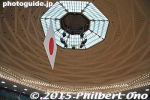
It's an annual New Year's ceremony and a joint practice session of all the major martial arts. Admission is free.The Budokan is near Kudanshita Station on the Tozai subway line.
|
|

The event starts at noon with an opening ceremony until 12:45 pm. Then at 12:45 pm, a procession of armored men appear (yoroi kizome).
|
|
|
|
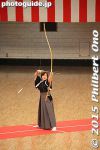
Martial arts demonstrations start at 1:15 pm and lasts until 2:30 pm. People from each martial art performed in turn. First was kyudo archery.
|
|
|
|
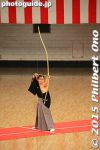
Kyudo archery
|
|
|
|
|

Kyudo archery
|
|
|

Jukendo
|
|
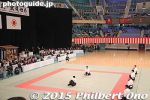
Aikido
|
|
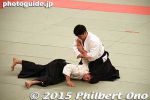
Aikido
|
|
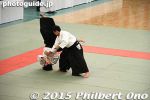
Aikido
|
|
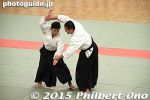
Aikido
|
|
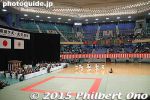
Karate
|
|
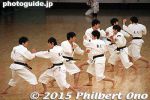
Karate
|
|
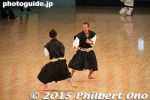
Shorinji Kenpo
|
|
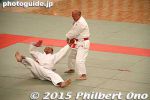
Judo
|
|
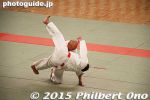
Judo
|
|

Officials and dignitaries watch.
|
|
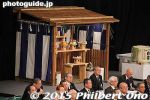
A small shrine
|
|
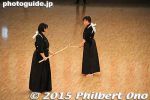
Naginata
|
|
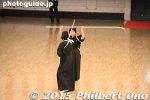
Naginata
|
|
|
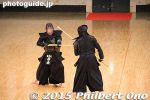
Kendo
|
|
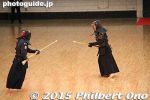
Kendo
|
|
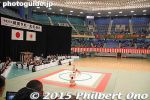
Sumo
|
|

Sumo. A college sumo club. Sumo ring is just a mat (no dirt) for Budo Hajime at the Budokan.
|
|

Sumo at the Budokan.
|
|
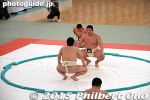
Sumo
|
|
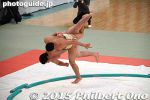
Sumo
|
|

They they all gathered and sat to listen to speeches.
|
|

Speech by a sports official.
|
|
|
|
|
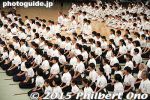
Naginata group
|
|
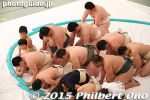
Sumo wrestlers
|
|

Then the Budo Hajime started with all the martial arts groups practicing at the same time.
|
|
|
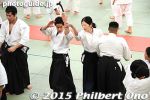
Aikido
|
|
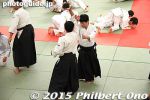
Aikido
|
|
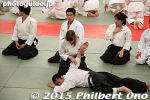
Aikido
|
|
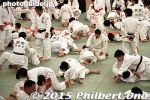
Judo
|
|

Judo
|
|

Judo
|
|

Kendo people were a noisy lot with their swords hitting each other.
|
|
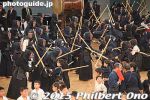
Kendo
|
|
|

Karate-do
|
|

Karate-do
|
|

Karate-do
|
|
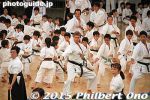
Karate-do
|
|
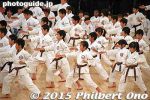
Karate-do
|
|
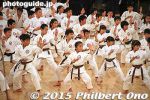
Karate-do
|
|

Naginata
|
|
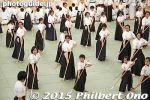
Naginata (pole sword). Naginata was the traditional weapon for woman warriors.
|
|
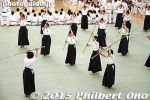
Naginata
|
|

Naginata
|
|
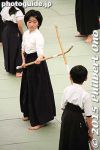
Naginata
|
|
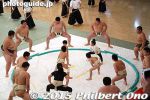
The sumo rikishi were from a college sumo club. I was hoping a Makunouchi wrestler would appear.
|
|
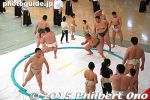
Sumo
|
|
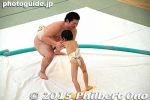
Sumo
|
|
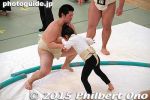
Sumo. Even little girls participated in Budo Hajime at Budokan.
|
|
|

Budo Hajime at the Budokan in early Jan. is a real spectacle. Kendo, judo, karate, sumo, naginata, kyudo.
|
|
|
|
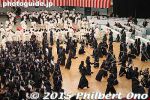
Kendo
|
|
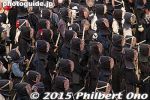
Kendo
|
|
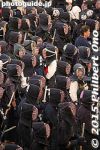
Kendo
|
|
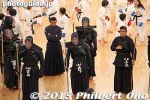
Kendo
|
|
|
|
|
|
|

The Budo Hajime ended at 3:10 pm. What a spectacle it was.
|
|
|
|

At the end, they served shiruko, a confection of azuki bean soup with a piece of mochi.
|
|
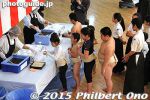
Martial artists line up for free shiruko.
|
|

Martial artists line up for free shiruko.
|
|
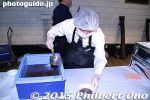
Serving shiruko.
|
|
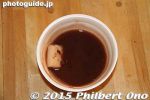
Shiruko, a confection of azuki bean soup with a piece of mochi. Served free of charge to everyone at the Budokan, including spectators.
|
|

Everyone ate their shiruko on the Budokan floor.
|
|
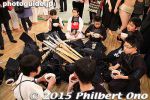
Eating shiruko.
|
|

The Budokan's gift shop. Is there any martial art where they say "Go for Block"? If not, it must mean "Go for broke!!"
|
|
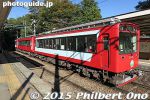
Hakone Open-Air Museum is near Chokoku no Mori Station on the Hakone Tozan Railway.
|
|
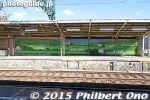
Chokoku no Mori Station on the Hakone Tozan Railway has a nice mural of the Open-Air Museum.
|
|
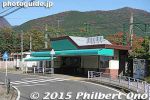
Chokoku no Mori Station on the Hakone Tozan Railway.
|
|
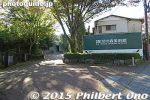
Way to Hakone Open-Air Museum. It opened in 1969 and operated under the Fujisankei Communications Group.
|
|

About Hakone Open-Air Museum. Allow at least 2 hours here.
|
|

Large, outdoor museum of exquisite sculptures. Many nudes (female). Also see the Picasso Pavilion. Both the art and 70,000-sq. meter garden-like grounds are very impressive.
|
|
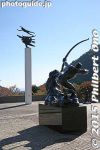
The first thing you see. Hercules and Pegasus. About 100 outdoor sculptures.
|
|
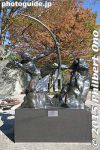
Hercules
|
|
|
|
|
|
|
|
|
|
|
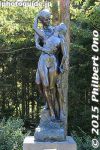
Hakone Open-Air Museum. Well worth a visit. But I wouldn't bring young children. Too many erotic/nude sculptures, mostly female.
|
|
|
|
|
|
|
|
|
|
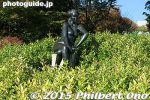
Nude near the Picasso Pavilion.
|
|
|
|
|

Hakone Open-Air Museum
|
|
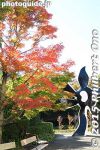
Maple leaves behind a Picasso sculpture in front of the Picasso Pavilion. Hakone is colder than Tokyo, but the cold autumn air feels great. It's a different kind of cold air that is refreshing and invigorating compared to urban Tokyo.
|
|
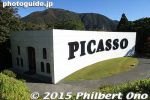
Picasso Pavilion has 300 works.
|
|
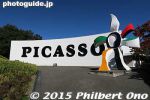
Picasso Pavilion
|
|
|
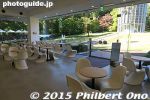
Cafe and Gallery
|
|
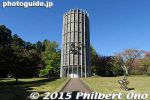
Also impressive was this stained glass tower named Symphonic Sculpture by Gabriel Loire.
|
|
|
|